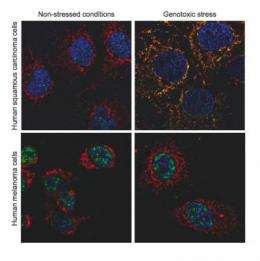Scientists find molecular switch that allows melanoma to resist therapy

The National Cancer Institute (NCI) estimates that as many as one in 51 men and women will be diagnosed with melanoma—the deadliest form of skin cancer—at some point during their lifetimes. A research team led by Ze'ev Ronai, Ph.D. at Sanford-Burnham Medical Research Institute (Sanford-Burnham) is working to unravel the molecular mechanisms underlying the development and progression of this disease in hopes of improving prevention and treatment strategies. To do this, Ronai's laboratory has been studying a protein named Activating Transcription Factor 2 (ATF2), which is associated with poor prognosis in melanoma.
ATF2 is a two-faced protein—in melanoma cells, it's oncogenic, or cancer-causing, while in non-malignant types of skin cancers, it acts as a tumor suppressor. In a paper published February 3 in the journal Cell, the team identified a molecular switch that controls ATF2's dual functions. This switch is controlled by protein kinase Cε (PKCε), which disables ATF2's tumor-suppressing activities, sensitizing cells to chemotherapy; instead, ATF2's tumor-promoting activity is enhanced. The team also found that high levels of PKCε in melanoma are associated with poor prognosis.
"PKCε is the culprit behind melanoma's 'oncogenic addiction,'" said Ronai, associate director of the Sanford-Burnham's NCI-designated Cancer Center and senior author of the study. "ATF2 is normally a 'good guy.' But when there is too much PKCε—as in malignant melanoma—ATF2 becomes an oncogene, promoting tumor development."
In this study, Ronai and lead author Eric Lau, Ph.D., a postdoctoral researcher in his lab, found that PKCε's malignant power is in its ability to direct ATF2's location and activity within a cell. In a normal cell, PKCε modifies ATF2, keeping it in the nucleus, where it turns genes on and off and helps repair damaged DNA. When the cell experiences exposure to toxicity or stress (radiation, for example), PKCε backs off and ATF2 is able to move out of the nucleus and to the mitochondria, the part of the cell that generates energy and helps control cellular life and death. When it gets there, ATF2 helps to set the cell on a death course—a safeguard cells use to prevent errors that often make them cancerous.
PKCε levels are abnormally high in melanoma, and more PKCε means more ATF2 stuck in the nucleus, where it can't help the cells to die. Instead, in the nucleus, ATF2 promotes cellular survival and thus contributes to tumor development.
"We found that melanoma patients with high PKCε levels in their primary tumors were more likely to experience shorter survival times," said Lau. "This finding is consistent with earlier analyses of human melanoma tumors that showed a similar correlation between increased nuclear ATF2 and poor clinical outcome."
The Ronai laboratory, in collaboration with Sanford-Burnham's Conrad Prebys Center for Chemical Genomics, is currently searching for small molecules that help release ATF2 from PKCε's grip, thereby resuming ATF2's ability to promote cell death when needed. Since such an approach will effectively kill melanoma cells, it is expected to offer new therapeutic options for melanoma, and possibly other tumors with high PKCε levels.
"This work has clear potential for translation from a basic laboratory discovery to a melanoma therapy," said Michael Jackson, Ph.D., vice president of drug discovery and development at Sanford-Burnham. "We are excited to begin the screening process to identify a new class of drugs to treat cancer."
















